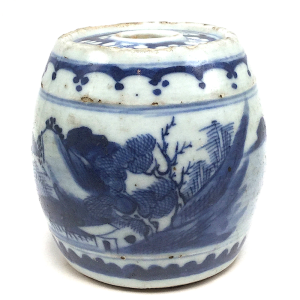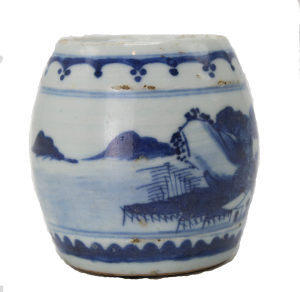-


$255.00
H: 3.25” Dia: 3.25” | FREE SHIPPING WITHIN CONTINENTAL U.S.!
This is unusual piece was likely on a scholar’s desk along with pots, brushes, water droppers, boxes, ink stones and other daily used objects used for a variety of tasks: a brush holder, a paper weight and more. With its round body covered with the landscape of a Chinese village, mountains and seas and the calligraphic name of the scholar owner Shu Dai Ji (舒逮吉) it would be perfect for placement on any style desk or in a study.
-


$135.00
H: 5” W: 5.25” D: 4.5” | FREE SHIPPING!
Utilitarian ceramics like this were used in home kitchens and restaurants to hold oil, sauces, soy or other liquids. This spouted blue and white porcelain jar has four loops, also called lugs, so a natural fiber such as rattan could be threaded to either secure a top create a way to hang it to a peg. Sealing the top was very useful if the jars contained liquid and needed to be transported. The piece is decorated in a free and expressive manner with a charming impression of a country scene of a building in a landscape surrounded by tall trees. The cobalt is thick and dark in some areas of the foliage and applied with a thin, sparing and light brush elsewhere.
End of content
End of content




